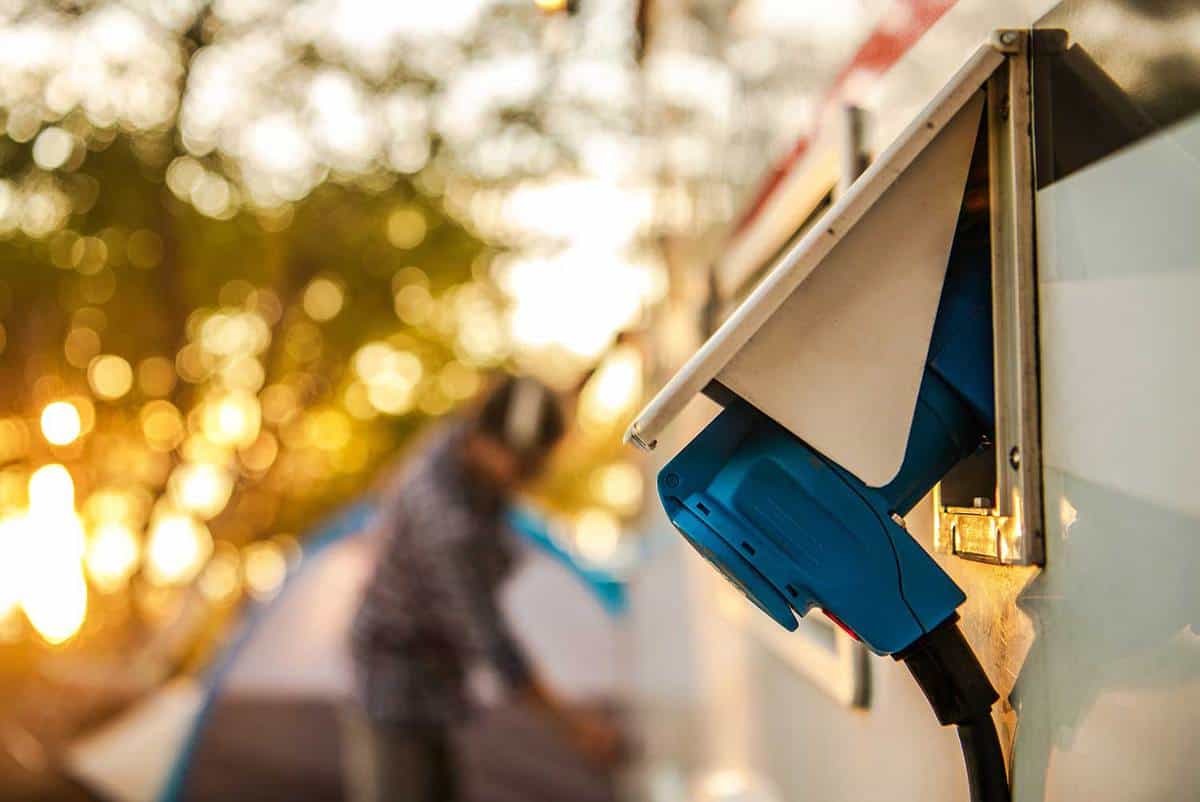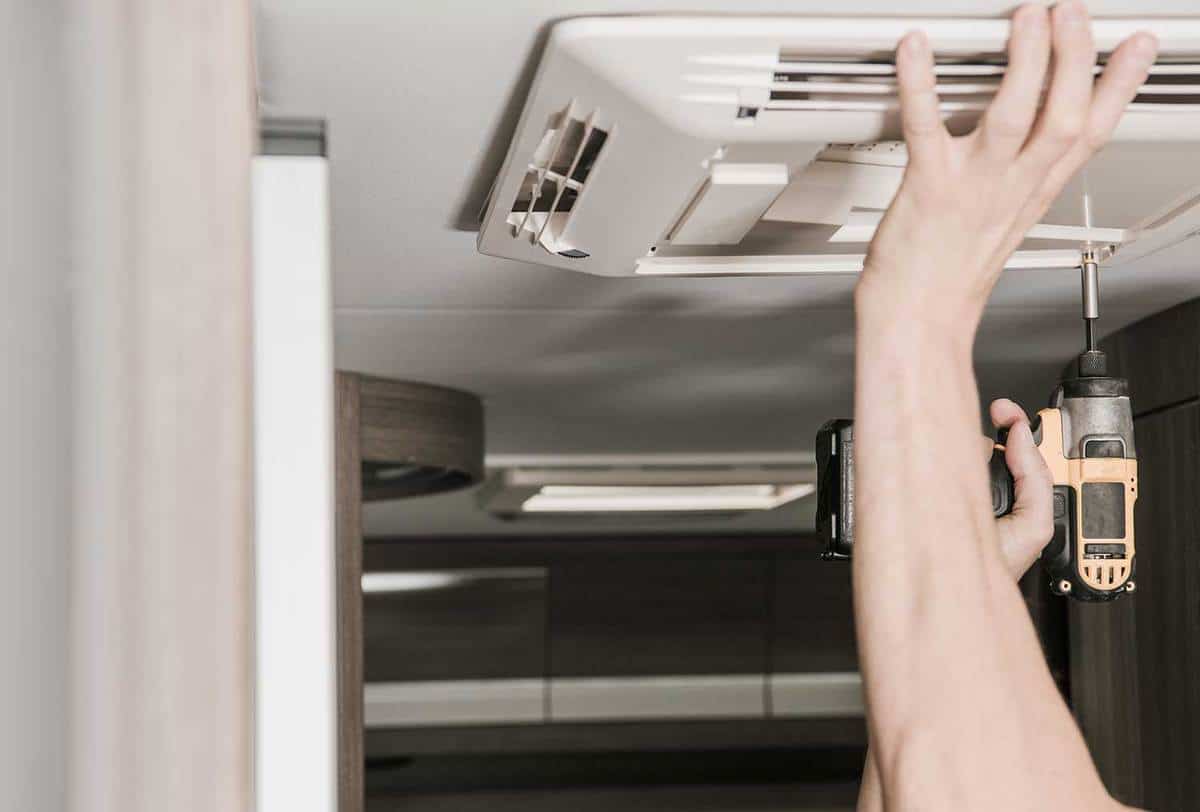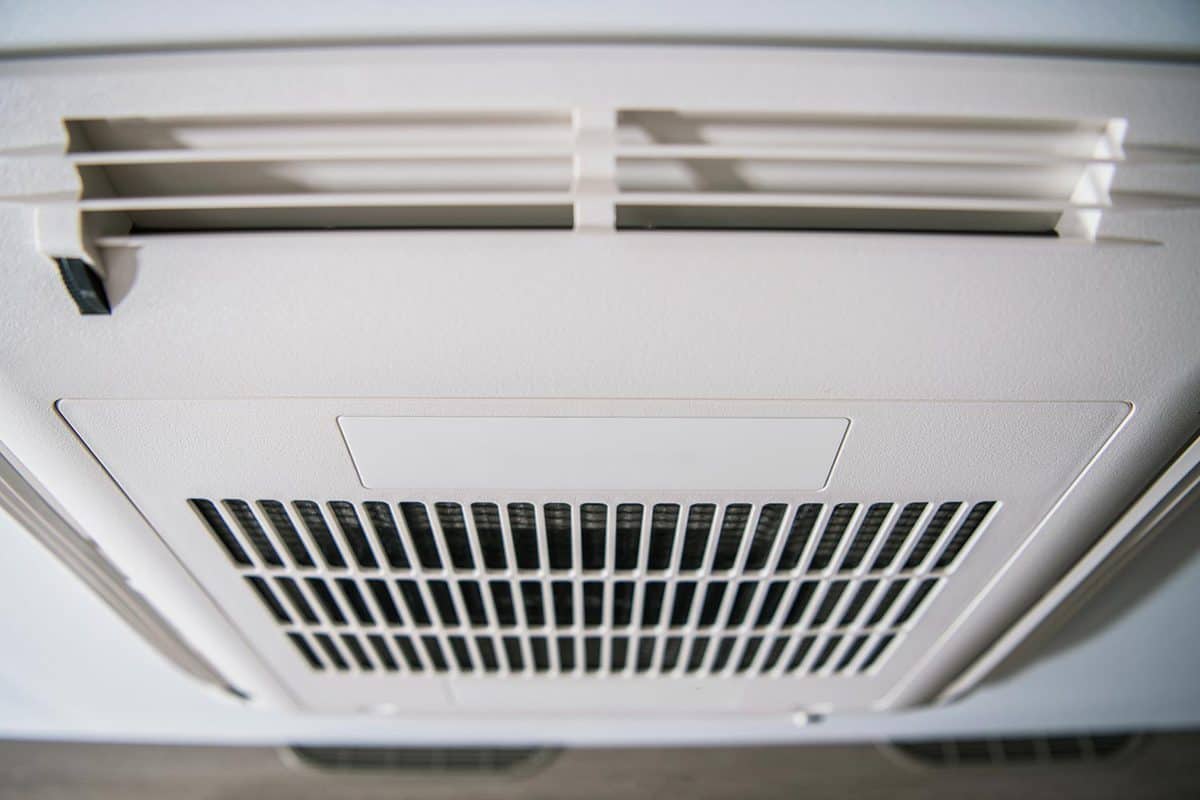Sometimes running one RV AC isn’t enough to bring comfortably cold temperatures to a fairly large camper. But is it possible to install a second AC to the RV? If so, how can you achieve this feat? We researched for you and also consulted with experts to give you the following answer.
If you're installing a second rooftop AC unit in your RV, you may need to remove the roof vent first. Then, have an assistant to help you lift the second RV AC to the roof. After setting the additional unit, the next steps are:
1. Mount and secure the interior metal plate. 2. Connect the wires for the AC while following the instructions. 3. Attach a CAT-5 cable from the AC and connect it to the RV’s thermostat. 4. Plug the AC to shore power.
Keep in mind that running a second RV AC needs the proper protocols in place. Otherwise, the connected circuit can blow or trip. Continue reading as we talk about how to run two air conditioners in an RV with minimal risks of blowing or tripping the breaker.
![A service worker lifting heavy air conditioner unit on the motorhome roof, Can You Add A Second AC To An RV [And How To]](https://vehq.com/wp-content/uploads/2021/12/Can-You-Add-A-Second-AC-To-An-RV-And-How-To-e1639392933577-683x1024.png)
Can A 30 Amp RV Run Two Air Conditioners?
A 30-amp circuit can run two RV air conditioners. However, the wiring connecting both cooling units should have proper electricity management. It’s not a plug-and-play affair, or else the switch might trip.

Take note that you cannot use more than the amount of power a 30-amp breaker can provide. Therefore, running a 12- and 24-amp RV air conditioner simultaneously on a single circuit can trip or blow it.
But if you can wire one air conditioner to produce four to seven amps while the compressor is running, the connected circuit may not trip. In turn, you should have enough power left for the other air conditioning unit.
You can also use a 50-amp adapter to increase the load limit of a particular switch. But this option will still have some shortcomings, particularly when the power source has a surge protector. If it has this feature, the switch can shut off automatically if it reaches a load of 30 amps or more, regardless of the existence of a 50-amp adapter.
Check out this 50-amp adapter on Amazon.
If you want to know more about how to run two air conditioners on a single 30-amp circuit, watch the video below:
Does An RV AC Need To Be Level?
In most cases, RVs need to be level for appliances and electronics like the AC to function correctly. Still, some AC units can work efficiently if the vehicle is on a slight incline. One example is the Furrion Chill Rooftop AC, which can operate at normal efficiency if the RV is on a 15-degree slant.
How To Install A Second RV Air Conditioner?

Before proceeding with this project, you need to ensure that you have some electrical know-how and you’re confident about pushing through with the task. Also, make sure to practice caution by wearing safety gear like gloves and goggles to avoid potential risks like electrocution.
Additionally, this operation may entail some parts removals. For instance, you may need to remove a roof vent to make way for the second RV AC unit. Check your RV’s owner’s manual or consult the vehicle’s manufacturer if you don’t know how to remove it.
After removing the vent, proceed with the next step:
Step-by-Step Guide
- Set the second AC unit to the hole where the vent was before. It’s best to ask for assistance for this step since a rooftop RV AC is quite heavy.
- Mount and secure the metal plate bracket in the interior section of the vent hole. Then, install the cover.
- Connect the wires that should come with the AC unit. Make sure to consult the instructions to avoid connecting wires to the wrong sockets.
- Attach a CAT-5 cable from the AC to the thermostat, which may require some planning with the routing.
- Plug the AC into a 20-amp shore power source.
You may also attach a 20-amp plug attachment to the end of the second AC’s cord to ensure that you’re not going to plug it in the wrong socket. Also, make sure to calculate your RV’s power usage while connecting its appliances to shore power. It’s because some of these sources will have a 50-amp source while others may only have a 30- or 20-amp option.
Watch the video below to know more information about the installation of a second AC unit to an RV:
Another option is to purchase and use a generator for the second AC. Keep in mind that the RV generator’s size needs to be appropriate. Read our post on that topic for more information.
Check out this 20-amp male plug replacement cord outlet on Amazon.
How Much Does It Cost To Install An RV Air Conditioner?
An RV air conditioner installation will cost roughly $200 to $1,000. But the overhead may depend on the specific unit, style, and professional labor. The expenses may also increase if you need to complete additional work before installing the AC.
For more information about the costs of RV AC installation, you can read our post on the rough expenses of replacing this appliance.
Is It OK For An RV AC To Run All Day?

It’s OK to leave an RV AC running all day. However, you need to think about some precautionary measures if you plan on making the AC unit blow cold air for an entire day.
For instance, it can be prudent if you cycle the thermostat’s energy output for the AC. In turn, the RV’s cooling system won’t be at a high risk of being overworked. But putting the AC on a low setting can put the coils in danger of freezing. Therefore, you need to pay attention to the thermostat’s automatic cycling time to prevent this issue from happening.
Additionally, leaving the AC on for extended periods may increase interior humidity. You may want to use a portable dehumidifier for this purpose.
Check out this portable dehumidifier on Amazon.
Is It OK To Run An RVs Air Conditioner When Plugged Into House Electricity?
Connecting and using one RV air conditioner while using house electricity as the main power source is possible. Using two RV ACs at the same time can be difficult, even when you connect them to a home’s electricity.
You also need to ponder upon some important factors before completing this setup. Some of the things you need to think about are:
- The house’s energy supply. Make sure to plug the RV AC into the correct outlet to avoid breaking or tripping the circuit.
- The correct adapter. You might need a 30- to 15-amp straight adapter for the setup.
- A reasonably long cord. Some properties may have long driveways, which can make it challenging to connect the AC to the house’s electricity if you’re using a short cord.
Moreover, you can't run multiple appliances at the same time when you're using the AC. Despite the AC unit being connected with house electricity, running other electronics like the microwave or refrigerator can trip the circuit.
Check out this 30- to 15-amp adapter on Amazon.
What Size AC Do I Need for RV?
Generally, an RV AC’s size is often proportional to its cooling potency. A fairly large AC unit may provide more cooling prowess than a relatively small model. Still, the rule of thumb that you should follow is to install a unit with a BTU of about 15,000.
10,000 BTU may not supply sufficiently cold temperatures in RVs during the summer. On the other hand, a 20,000 BTU model might increase energy costs.
You should also take note of the available power supplied by the vehicle. Bear in mind that a single RV battery can’t supply enough power to a typical RV AC. However, you can run a single AC to two deep cycle 6-volt batteries. But the running time for this setup is only about an hour at most before the power in those batteries runs out.
Other factors that you need to think about for the installation of a new RV AC are:
- Vehicle's size
- Type of AC
- Available space
- Desired usage
Final Words
Practice proper safety protocols before initiating the installation of a second RV AC unit. Also, ensure that the wires are in the right sockets to avoid issues like short circuits. Finally, plug the AC into the correct power source to prevent blowing or tripping the circuit.




